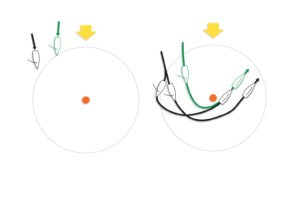
Death Rolling
The breeze is up, howling down the river in dark puffs that dart towards your CJ. On the first beat, you’re easing the jib, hiking your booties off, and keeping an eye out for possible auto-tacks. At the windward mark, you’re making a solid layline call and navigating through starboard tackers. Then the windward offset comes, and you carve down around it—and suddenly you’re sailing downwind in a CJ in heavy air, one of the most precarious situations in college sailing.
Between medium breeze and all-out survival conditions, there lies a vital setting—stability mode. Staying upright and still moving quickly in heavy air CJ sailing involves three main things: weight placement (especially during jibing and winging), vang adjustments, and constant attention to what’s blowing towards you. Especially in shifty venues, a quick, skilled crew is invaluable in the front of the boat, whether or not they’re a “heavy.” If you overcompensate on the run and go into survival mode before you need to, you risk moving slowly and losing boats. On the flip side, one false move can have you swimming in the Charles, watching your competitors blow by you as you scramble to right your unruly vessel.
In heavy air, you must have no fear; fear leads to flipping. Be confident, albeit careful, in your movements, and have open and clear communication with your skipper. When it’s time to jibe, you’ll need to work with your skipper to make sure it’s executed without a hitch. Going full speed, your skipper will turn the boat dead downwind and bring the main over—if you see that the main is not easily crossing the boat, you can give the vang a tug to help it come across. Then you need to flatten the perfect amount to help the boat bear off from the turn—too little and the boat will carve up, too much and the boat will flip. A lot of this will be based on feel; you can feel the boat load up, based on your speed and angle during the jibe, and adjust your flatten accordingly. Practice here makes perfect.

Hand the jib sheet around the shroud when you’re winging and keep the boat stable. Photo: Bill Records
Next, winging. You will likely be winging the entire run, so you need to be able to do it perfectly and on the first try every time. Like with gybing, if you can smoothly go to the wing at full speed you’ll be incredibly fast, so be sure that your skipper is prepared before you pop your jib over. You need to hand it to them around the shroud without destabilizing the boat, so keep your weight in the middle while you move only your arm. If they can scoot forward to grab it after you’ve popped it over, this is even better as it will prevent having too much weight to windward. All movements in heavy air need to be smooth—anything erratic, such as slamming your body down on the rail, can easily lead to a capsize.

Now it’s time to settle in. The most basic rule for body placement in breeze is spread your weight (see photo at right). While your skipper sits on the windward rail, you should sit down—on the centerboard trunk in less breeze and directly on the leeward rail in anything above roughly 15 knots (lower if the venue is particularly shifty, higher if it’s directionally steady). If your boat feels at all unstable, put down the board and spread your weight more; move your body out even further to leeward. If you see a death puff headed your way, you can literally hike out to leeward in an attempt to keep the boat stable. Be careful of getting your back caught on the main sheet, as it can prevent you from ooching and moving both out and backwards (and if your bow ever starts to dig in, you’re going to want to move back quickly!).
No matter how well-placed your weight is, improper vang trim can still take you down if you’re not on your toes. When it’s breeze on, err on the side of cranking that vang on in a CJ as hard as you can. To check your trim, look up at the main; you want the top batten to be perpendicular to the breeze. If it’s hooked, or curved backwards, then you have too much vang on and you need to ease it a bit. If it’s too open, then you’re spilling breeze out of the top of your main—not fast, and also not stable. Use both hands and all your core strength to pull on the vang if you must; it is a top priority on a puffy run. In light spots, don’t forget to ease it off or you’ll find yourself stalled and slow—but be prepared to put it back on when you see the next breeze line coming.
That leads to the final vital aspect of stability mode: constant vigilance. If it’s windy enough that you’re sitting directly on the leeward rail, you should be facing backwards and calling out puffs. Your skipper will be focused on playing the sail and keeping the boat upright, so it’s important for you to let them know what’s coming your way. If you see a death puff headed towards you, stay calm; inform your skipper when it’s going to hit and whether it’s going to be a knock or a lift, crank the vang, put down the board, and spread your weight. Once you’ve weathered it, ease vang, raise the board, and centralize your weight at least a little to keep your boat competitive and flying downwind. There is one catch—you as the crew can do all of these things right, but if you’re sailing by the lee and a big lift hits your sails, you’ll still death roll despite your best efforts. So don’t let you skipper sail by the lee in these conditions! The cassette tape telltales that you should have put on the shrouds are not just for their eyes; if they’re streaming to windward instead of to leeward, point this out to your skipper. They should then make the decision to head up or execute a careful jibe, returning your boat to a relatively safe angle to the breeze.
Never let your guard down in a CJ in breeze, but don’t forget to have a little fun with it and enjoy the wild ride. Let your adrenaline pump as you count down to the next tiny Armageddon—as long as you’re prepared you should stay upright even as your competitors rock unsteadily and capsize. Know what to expect and “present your boat for Mother Nature,” as Buddy Melges would say—and don’t forget to adjust to the relative lulls too!
Amelia Quinn is a senior at Tufts University, studying a little bit of Arts and Sciences and a lot of sailing. Find more of her blogs here, and pick up our March 2013 issue for our annual Guide to College Sailing.









